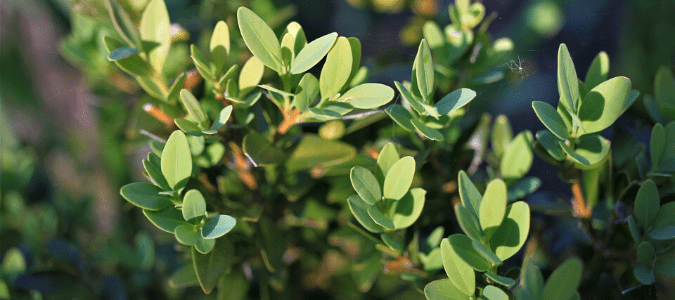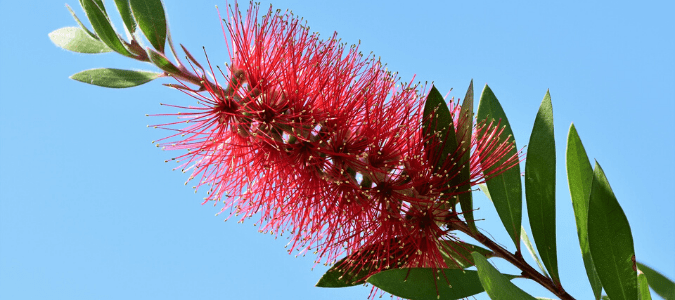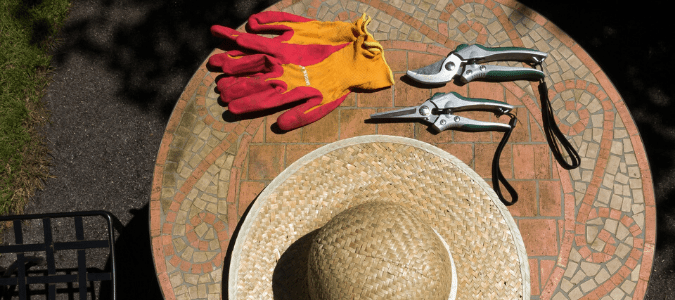
Homeowners often choose to add bushes to their front yards to add height and texture, enhance security and improve the aesthetic appeal of a landscape. If you are considering making this investment and you live in the Lone Star State, you probably want to learn more about Texas evergreen shrubs, particularly since you want to make sure your new plants survive in our hot and dry climate. Usually, your best bet is to consult with a landscaping professional to recommend which species would work best in your yard, given not only our climate, but also your soil type, sun exposure and watering preferences. If you’d prefer to go the DIY route, however, we have a few suggestions for you.
Yaupon Holly
Whether you’re looking for an evergreen hedge or a topiary plant, yaupon holly is a popular choice in residential areas, and for good reason. This evergreen shrub is easy to trim and grow, and it produces beautifully striking red berries that will attract wildlife to your yard. Without any pruning, these plants grow to 15 to 25 feet tall and 15 to 20 feet wide, but they can easily be kept smaller with a little maintenance. Additionally, there are dwarf varieties available if you would prefer a smaller footprint. The yaupon holly can grow in anything from full sun to full shade, though it will grow more quickly in the sun, and it is a relatively salt-tolerant plant if you live in a coastal area. Even more important for Lone Star State residents, these plants are drought tolerant once they have been in the ground for a few years, but can also survive temporary poor drainage. If you choose to add this variety to your landscape, you’ll want to be sure to water during dry times to keep your plants healthy.
Glossy Abelia
If you want a non-traditional evergreen shrub, consider glossy abelia. This moderately-sized shrub stays between 3 and 6 feet tall, and produces beautiful flowers from spring to fall ranging in color from white to pink. It keeps its leaves year-round, but they turn a unique coppery-bronze color in the fall and winter. This shrub is great for attracting birds and butterflies to your yard and is a good option for you if you’re trying to keep deer out of your garden, as they don’t usually feed on these plants. Glossy abelia can be used as a single plant or as a shrub border. These plants prefer partial to full sun and bloom best in the light. Water thoroughly once a week in dry times to help your bushes thrive during dry spells. This plant blooms on its newest growth, so trim it back every few years in late winter to encourage flowering the next spring.
Japanese Boxwood
Pictured above, this plant is a dense, compact evergreen shrub that is perfect for adding a touch of elegance. Many gardeners use Japanese boxwoods in true formal gardens, so they are associated with sophistication. This shrub is relatively short, growing anywhere from 2 to 5 feet high. Japanese boxwood shrubs are commonly used as hedges or elegant borders. These plants can survive well in Texas heat, as long as they are planted in areas with partial sun or dappled shade. When watered well once a week during dry periods, this plant will thrive for decades.
Thorny Elaeagnus
Thorny elaeagnus, also known as thorny olive, silverthorn and spiny oleaster, is a medium to large evergreen shrub that develops extremely fragrant flowers in the fall with two-tone leaves—dark green above and silvery-white beneath. This shrub grows to be 8 to 15 feet tall and wide and is adaptable to nearly any environment. The thorny elaeagnus can tolerate extreme heat, as well as the cold, and can tolerate soggy soil for short periods of time. In addition to being used for erosion control, this shrub is commonly used as a screening hedge, shrub border and even a formal hedge, as long as you’re committed to keep on top of your pruning.
The list of Texas evergreen shrubs doesn’t stop there. If you’re looking for a taller evergreen shrub, other great options include mountain laurel, cherry laurel and Texas rose bud. If you’re looking for a smaller evergreen shrub, Asiatic jasmine and silverfoot pony will work well.
When it comes to planting shrubs, different homeowners have different needs. While some people would prefer to have evergreen shrubs, others prefer to plant shrubs that will become established in their yard quickly. Or, for a more complete look, you can plant a combination of these shrubs to keep your yard looking beautiful and lush. Keep on reading for more ideas on plants to add to your Texas outdoor spaces.

Fastest Growing Shrubs in Texas
If you’re putting in new landscaping, you probably want these plants to get established quickly. By planting fast-growing shrubs, you can enjoy the benefits of these plants sooner, whether you chose these additions to get more privacy, help prevent soil erosion and or even give local wildlife a habitat to nest in.
Hannah Ray Bottlebrush
There are multiple varieties of bottlebrush plants, and almost all of them grow quite quickly. Hummingbirds and butterflies love all varieties of bottlebrush, and it’s a great option for homeowners for a variety of reasons. These plants are drought-tolerant once they are in the ground, and they are also particularly attractive, as you can see in the picture above. This heat-tolerant plant averages about 10 to 15 feet tall and produces large bright red flowers from spring through fall. Hannah Ray bottlebrush is also known for its “weeping” habit, leading to an elegant draping shape.
Wax-Leaf Privet
The wax-leaf privet grows quickly and averages about 6 to 8 feet tall at maturity. These plants, also sometimes commonly referred to as Japanese privets, accept pruning easily and can be trimmed into spherical or conical shapes. The waxy leaves can be flat diamonds or wavy, unique clusters, depending on the plant. In late spring, wax-leaf privets develop large clusters of fragrant off-white flowers that attract pollinators. These plants do well in anything from full sun to shade. Since they are drought-tolerant plants once established, they are a great addition to a variety of landscapes.
Arabian Lilac
The Arabian lilac, also known as Asa vitex or chaste tree, is a quick-growing shrub that’s beloved for its distinctive flowers and foliage. The leaves have showy purple undersides, so these plants are a great accent even when they aren’t flowering. During the summer months, blossoms appear which are tight dark purple clusters that attract butterflies. The flowers make way to black-colored berries that add additional color for the winter months. Arabian lilacs do best in full sun to partial shade, and they’re drought-tolerant.
Now that you have a better idea of what types of shrub you may want in your yard, you probably want to know when to plant your shrubs to ensure that they grow healthy and strong. Let’s go over some tips to help your new plants get the best start.

Best Time to Plant Shrubs in Texas
When you’re interested in adding new shrubs to your yard, it’s important to understand how to best care for these plants. Choosing the right time to plant shrubs and other plants can be the difference between a thriving landscape and a yard that dies in the heat of summer.
Many landscaping professionals agree that fall is the best time to add new shrubs to your yard. Plants benefit from having a winter to get established, which is especially true in a state that’s as hot and dry in the summers as Texas (and often into the fall and spring). Plant roots can grow as long as the soil is above freezing. In many places in Texas, the soil remains warmer than that year round. If you follow this advice and cover your plants during the coldest nights of the year, by the time spring and summer arrive, your plants are well-established and able to beat the summer heat.
Of course, taking care of your newly-transplanted shrubs will help them become established. Routine lawn maintenance is key to helping both grass and plants live and thrive for years. One of the most important things you can do is to water your new plants. Once your plants are in the ground, water them thoroughly. This extra moisture helps these newly-planted shrubs adjust to their new home. Continue to repeat this soaking once every week to two days for one to two weeks after planting. You can then water once every two to three days after that and up until 12 weeks after planting. Then, you can water weekly for a year or two, at which point your plant will be established.
Another thing you can do to help your shrubs stay healthy is to surround the trunk with mulch. Four to six inches of mulch covering the root ball will help keep moisture in the soil and prevent pests and weeds. Mulch also takes care of any fertilizing the shrub may need. You’ll want to keep the mulch away from the trunk to prevent rot.
Finally, many shrubs benefit from pruning and pesticide applications, which may be offered as a part of your regular lawn services. Some shrubs only flower on new growth, while others can quickly get oversized without trimming. A landscaping professional can help you transplant and maintain your plants, so they continue to thrive and be a thriving part of your landscape for years to come.
ABC Can Give Your Landscape An Upgrade
We are lucky to have many different options here in Texas when it comes to evergreen and fast-growing shrubs. However, it can be overwhelming to determine which shrubs will work best with your soil type, sun exposure and yard’s color scheme. If you need help with any aspect of your landscaping or need lawn service, ABC Home & Commercial Services can help. Our landscape designers have a thorough understanding of which species thrive in our local areas and can advise you on which will work best for your particular yard. Once these plants are in the ground, you can leave all aspects of your yard care to our trained and knowledgeable lawn care specialists. With ABC’s help,
